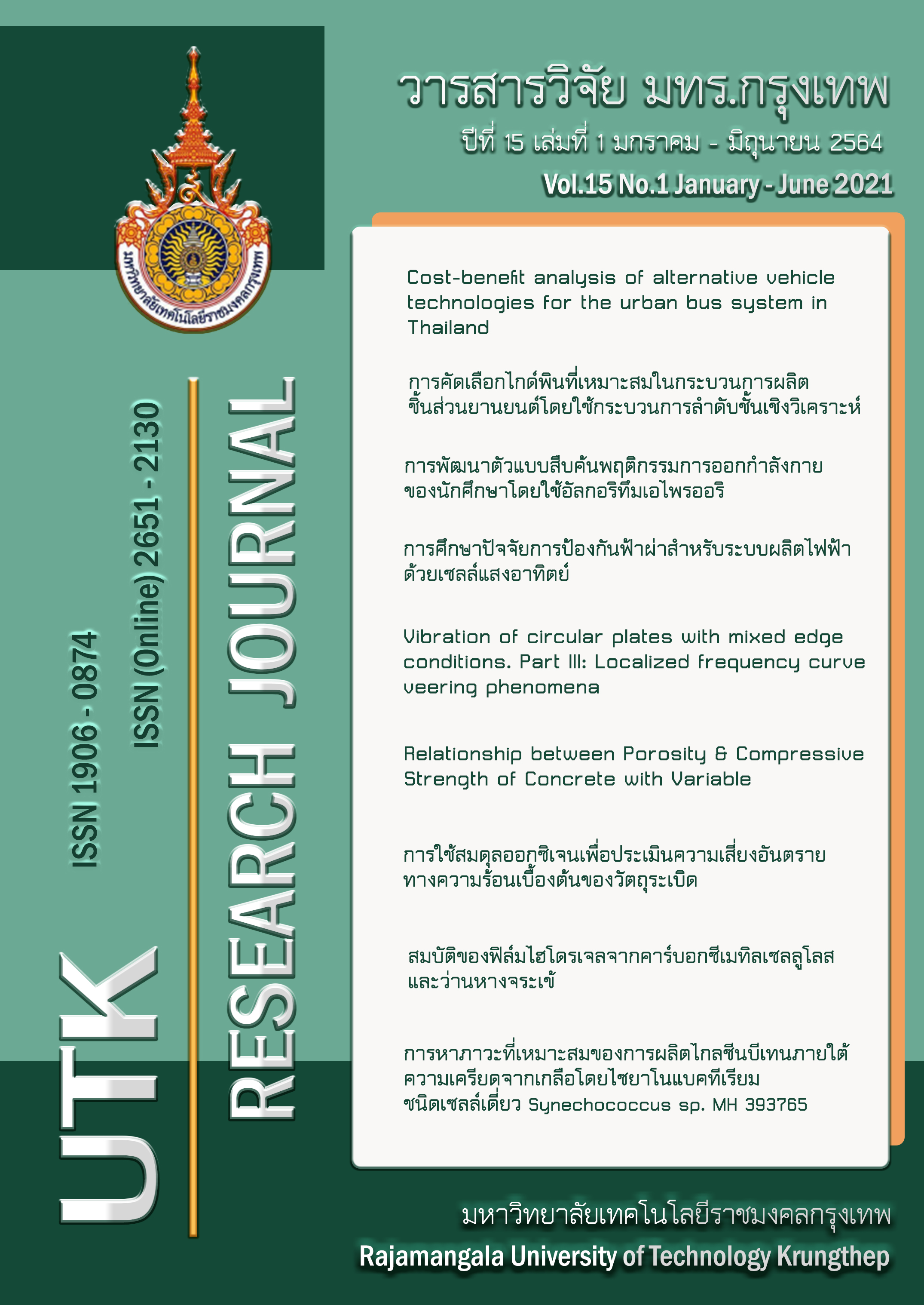Relationship between Porosity & Compressive Strength of Concrete with Variable W/C Ratio
คำสำคัญ:
Hardening concrete, Compressive strength, Effective porosity and Water to cement ratioบทคัดย่อ
This research used a comprehensive experimental program. The objective of this research was to quantify and investigate the correlation between effective porosity and compressive strength of concrete developed during the curing process. Compressive strength and porosity of concrete were tested at ages of 1, 3, 7, 14, 28, and 56 days, respectively and concrete cylinder samples were prepared with different water to cement (w/c) ratio of 0.40, 0.55 and 0.70. The hardening concrete's compressive strength was increased with curing time, while effective porosity measurements was in opposite pattern.The relationship between effective porosity and compressive strength of concrete has been as an empirical correlation. The time-dependent measurements are beneficial in better understanding in term of hardening concrete's pore structure development.
เอกสารอ้างอิง
Mehta P, Monteiro P. Concrete Structure, Properties, and Materials. 4nd Ed. New Jersey. USA: Prentice Hall; 1993.
Popovics S. Method for developing relationships between mechanical properties of hardened concrete. J Am Concr Inst. 1973; 70: 795 - 8.
Popovics S. New formulas for the relationships for the prediction of the effect of porosity on concrete strength, J Am Concr Inst 1985; 82: 136 - 46.
Pann KS, Yen T, Tang CW, et al. New strength model based on water-cement ratio and capillary porosity, ACI Mater J 2003; 100 (4): 311 - 8.
Michael J M ,Thomas D D. Pozzolanas and Pozzolanic Materials. Lea's Chemistry of Cement and Concrete (Fifth Edition) 2019; 363 - 467.
Mindess S, Young J, Darwin D. Concrete. 2nd edition. London: Pearson Education; 2002.
Neville A. Properties of Concrete. 4th Edition. Longman House. Harlow; 1995.
Treval C P, Helmuth R A. Theory of volume changes in hardened Portland cement paste during freezing Highw. Res Board Bull. 1953; 32: 285 - 297.
ACI 211 The American Concrete Institute (ACI) Standard Practice for Selecting Proportions for Normal, Heavyweight, and Mass Concrete (ACI 211.1 - 91). ACI Manual of Concrete Practice. Part 1: Materials and General Properties of Concrete. USA; 2000.
American Society of Testing Materials. ASTM C39 - 14. Standard Test Method for Compressive Strength of Cylindrical Concrete Specimens. ASTM International, West Conshohocken, PA; 2020.
ASTM C 642 - 97 Standard Test Method for Density, Absorption, and Voids in Hardened Concrete. American Society for Testing and Materials. USA; 1997.
Kakizaki M, Edahiro H, Tochigi T, et al. Niki.Effect of Mixing Method on Mechanical Properties and Pore Structure of Ultra High - Strength Concrete. Katri Report No. 90. Detroit: Michigan; 1992: 19
Alexander K M, Ivanusec I. Long term effects of cement SO3 content on the properties oh normal and high - strength concrete. Part I. The effect on strength. Cement and Concrete Research, 1982; 12 (1): 51 - 60.
Newman J, Cho B S.Advanced Concrete Technology Constituent Materials 1st edition. London: Burlington MA; 2013.
Odler I, Rossler M. Investigations on the relationship between porosity, structure and strength of hydrated Portland cement pastes. II. Effect of pore structure and of degree of hydration. Cement and Concrete Research 1985; 15 (3): 401 - 10.
ดาวน์โหลด
เผยแพร่แล้ว
รูปแบบการอ้างอิง
ฉบับ
ประเภทบทความ
สัญญาอนุญาต
กองบรรณาธิการวารสารวิชาการ มหาวิทยาลัยเทคโนโลยีราชมงคลกรุงเทพ มีความยินดีที่จะรับบทความจากอาจารย์ นักวิจัย นักวิชาการทั้งภายในและภายนอกมหาวิทยาลัย ในสาขาวิชาวิทยาศาสตร์และเทคโนโลยี ได้แก่ สาขาวิชาวิทยาศาสตร์ วิศวกรรมศาสตร์ และสาขาอื่นๆ ที่เกี่ยวข้อง รวมถึงสาขาต่างๆ ที่มีการบูรณาการข้ามศาสตร์ที่เกี่ยวข้องวิทยาศาสตร์และเทคโนโลยี ที่เขียนเป็นภาษาไทยหรือภาษาอังกฤษ ซึ่งผลงานวิชาการที่ส่งมาขอตีพิมพ์ต้องไม่เคยเผยแพร่ในสิ่งพิมพ์อื่นใดมาก่อน และต้องไม่อยู่ในระหว่างการพิจารณาของวารสารอื่น
การละเมิดลิขสิทธิ์ถือเป็นความรับผิดชอบของผู้ส่งบทความโดยตรง บทความที่ได้รับการตีพิมพ์ต้องผ่านการพิจารณากลั่นกรองคุณภาพจากผู้ทรงคุณวุฒิและได้รับความเห็นชอบจากกองบรรณาธิการ
ข้อความที่ปรากฏอยู่ในแต่ละบทความที่ตีพิมพ์ในวารสารวิชาการเล่มนี้ เป็นความคิดเห็นส่วนตัวของผู้เขียนแต่ละท่าน ไม่เกี่ยวข้องกับมหาวิทยาลัยเทคโนโลยีราชมงคลกรุงเทพแต่อย่างใด ความรับผิดชอบด้านเนื้อหาและการตรวจร่างบทความแต่ละบทความเป็นของผู้เขียนแต่ละท่าน หากมีความผิดพลาดใดๆ ผู้เขียนแต่ละท่านจะต้องรับผิดชอบบทความของตนเองแต่ผู้เดียว
กองบรรณาธิการขอสงวนสิทธิ์มิให้นำเนื้อหา หรือข้อคิดเห็นใดๆ ของบทความในวารสารวิชาการ มหาวิทยาลัยเทคโนโลยีราชมงคลกรุงเทพ ไปเผยแพร่ก่อนได้รับอนุญาตจากกองบรรณาธิการ อย่างเป็นลายลักษณ์อักษร ผลงานที่ได้รับการตีพิมพ์ถือเป็นลิขสิทธิ์ของวารสาร






